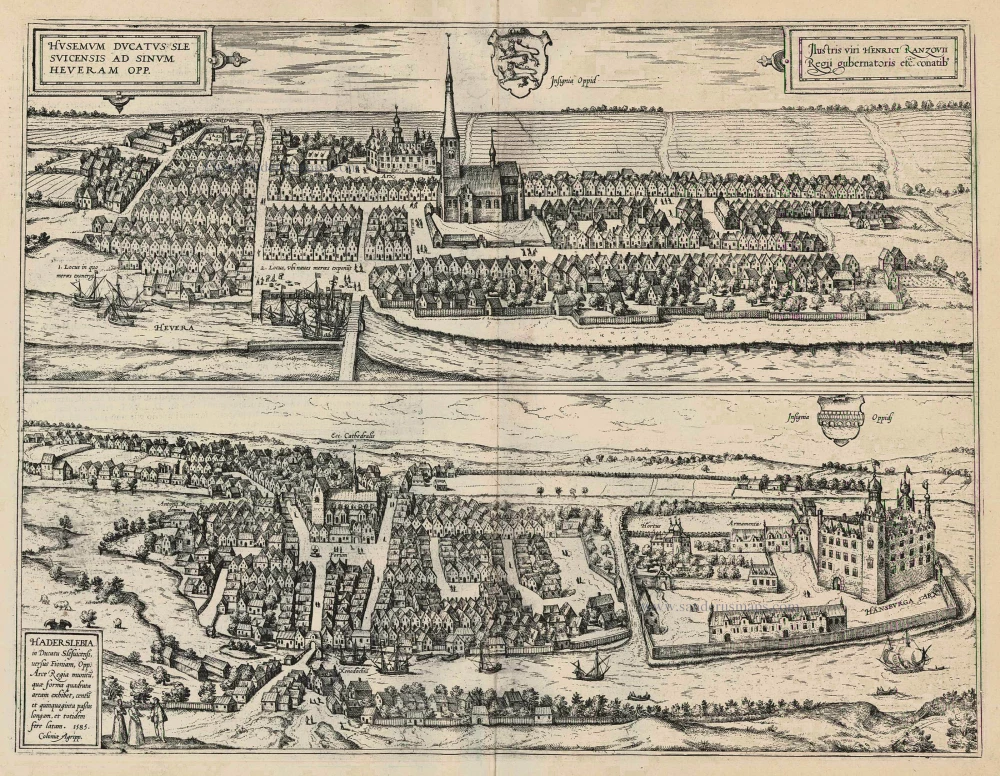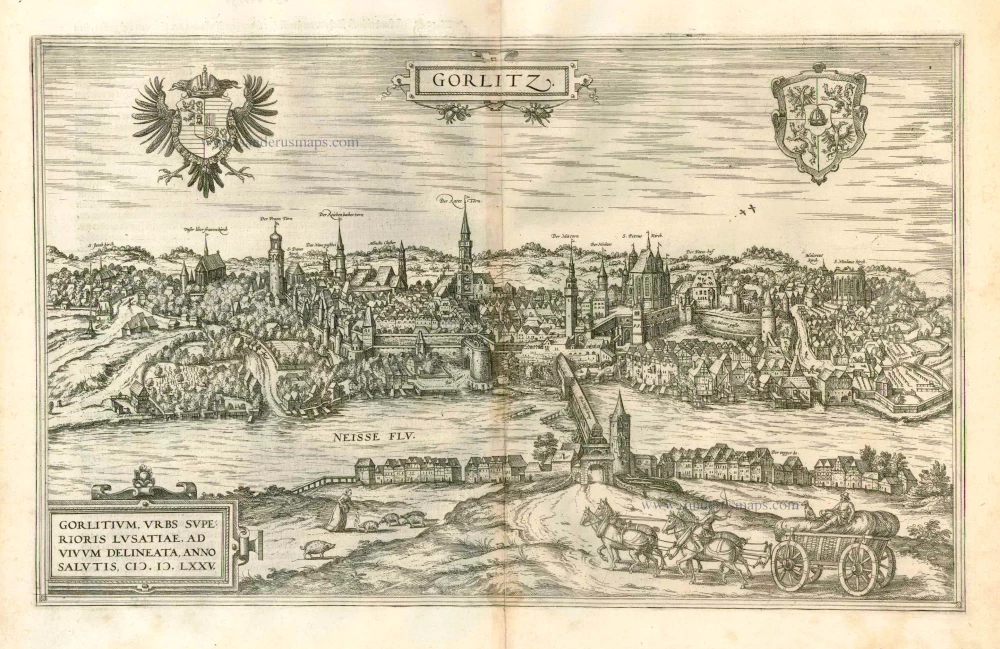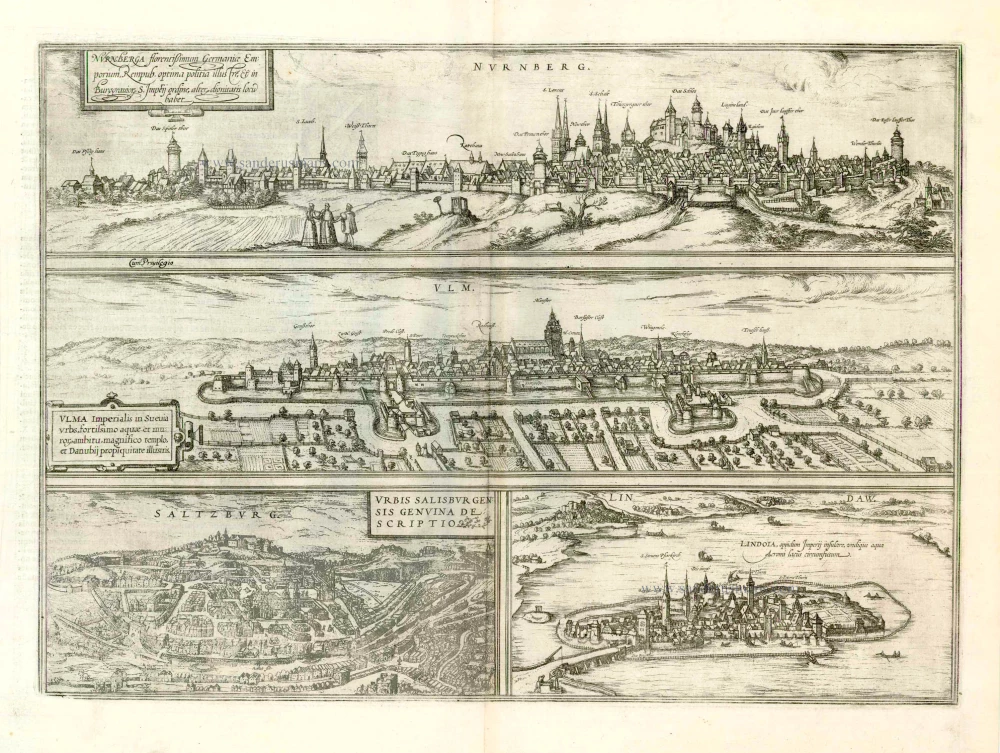Husum and Haderslev, by Georg Braun and Frans Hogenberg. 1599
HUSUM
CARTOUCHE LEFT: Husum, a town in the Duchy of Schleswig on the Hever coast.
CARTOUCHE RIGHT: Recorded by the illustrious gentleman Heinrich Rantzau, viceroy of the King, etc.
COMMENTARY BY BRAUN (on verso): "Husum, a town in Schleswig situated in the territory ruled by Adolf, Duke of Schleswig, has a shipping port celebrated for its far-flung commerce and trade links. To it the city owes the bend or twist made by the large arm of the sea called the Hever so that it extends as far as Husum. Hence it is easy to go by ship from here to Holland, Zeeland, England and Scotland, which is, conversely, the reason why so many goods arrive here for transhipment to Flensburg, which is only five miles distant, that is, from the North Sea to the Baltic."
This view, looking north from a slightly elevated vantage point, shows the unfortified town on the Hever, with ships on it. At the centre is the church of St Mary, consecrated in 1436. Behind it is the castle built by Duke Adolf from 1577 to 1582. First mentioned in 1409, Husum was the most important North Friesland port in the late 15th century. It owed this status to a storm flood, which swept away much of the North Friesland coast in 1362, turning an inland settlement into a port town overnight. Husum was not made a free city until the early 17th century. Active in Husum from 1512 to 1521, the celebrated Hans Brüggemann produced his masterpiece, the Bordersholm Altarpiece. Husum was fondly addressed as " O grey town on the sea" by a famous son, the writer Theodor Storm.
HADERSLEV
CARTOUCHE: Haderslev, a town in the Duchy of Schleswig across from Funen, is defended by a royal fort that is square in ground plan, 150 paces long and nearly as many wide. 1585 at Cologne.
COMMENTARY BY BRAUN (on verso): "Haderslev, a town in the Duchy of Schleswig, was incorporated and granted its civic privileges in the year of our lord 1292 by Waldemar, Duke of Jutland. Once, it had a fortified castle on an elevation. [...] Moreover, it also has a secure harbour or safe haven for mooring ships. It extends into the Baltic across from Finland, surrounded by fertile, arable land on all sides in the immediate environs."
This view with sea-going vessels indicates the importance of Haderslev as a trading port situated on a man-made peninsula at the end of Haderslev Fjord. In the Middle Ages, it was one of the most prosperous ports in the region. In 1544 Haderslev became a seat of the territorial government. The fortress to the east of the city was replaced by the magnificent Habsburg castle, which was besieged and destroyed by the Swedes in the 17th century and never rebuilt. The High Gothic church of St Mary was, after Schleswig cathedral, the largest in the former bishopric of Schleswig. Haderslev lost its importance as a port because the fjord and harbour were too narrow for larger ships to be able to manoeuvre in them.
Braun G. & Hogenberg F. and the Civitates Orbis Terrarum.
The Civitates Orbis Terrarum, also known as the 'Braun & Hogenberg', is a six-volume town atlas and the most excellent book of town views and plans ever published: 363 engravings, sometimes beautifully coloured. It was one of the best-selling works in the last quarter of the 16th century. Georg Braun, a skilled writer, wrote the text accompanying the plans and views on the verso. Many plates were engraved after the original drawings of a professional artist, Joris Hoefnagel (1542-1600). The first volume was published in Latin in 1572 and the sixth in 1617. Frans Hogenberg, a talented engraver, created the tables for volumes I through IV, and Simon van den Neuwel made those for volumes V and VI. Other contributors were cartographers Daniel Freese and Heinrich Rantzau, who provided valuable geographical information. Works by Jacob van Deventer, Sebastian Münster, and Johannes Stumpf were also used as references. Translations appeared in German and French, making the atlas accessible to a broader audience.
Since its original publication of volume 1 in 1572, the Civitates Orbis Terrarum has left an indelible mark on the history of cartography. Seven more editions followed the first volume in 1575, 1577, 1582, 1588, 1593, 1599, and 1612. Vol.2, initially released in 1575, saw subsequent editions in 1597 and 1612. The subsequent volumes, each a treasure trove of historical insights, graced the world in 1581, 1588, 1593, 1599, and 1606. The German translation of the first volume, a testament to its widespread appeal, debuted in 1574, followed by the French edition in 1575.
Several printers were involved: Theodor Graminaeus, Heinrich von Aich, Gottfried von Kempen, Johannis Sinniger, Bertram Buchholtz, and Peter von Brachel, all of whom worked in Cologne.
Georg Braun (1541-1622)
Georg Braun, the author of the text accompanying the plans and views in the Civitates Orbis Terrarum, was born in Cologne in 1541. After his studies in Cologne, he entered the Jesuit Order as a novice, indicating his commitment to learning and intellectual pursuits. In 1561, he obtained his bachelor's degree; in 1562, he received his Magister Artium, further demonstrating his academic achievements. Although he left the Jesuit Order, he continued his studies in theology, gaining a licentiate in theology. His theological background likely influenced the content and tone of the text in the Civitates Orbis Terrarum, adding a unique perspective to the work.
Frans Hogenberg (1535-1590)
Frans Hogenberg was a Flemish and German painter, engraver, and mapmaker. He was born in Mechelen as the son of Nicolaas Hogenberg.
By the end of the 1560s, Frans Hogenberg was employed upon Abraham Ortelius's Theatrum Orbis Terrarum, published in 1570; he is named an engraver of numerous maps. In 1568, he was banned from Antwerp by the Duke of Alva and travelled to London, where he stayed a few years before emigrating to Cologne. He immediately embarked on his two most important works, the Civitates, published in 1572 and the Geschichtsblätter, which appeared in several series from 1569 until about 1587.
Thanks to large-scale projects like the Geschichtsblätter and the Civitates, Hogenberg's social circumstances improved with each passing year. He died as a wealthy man in Cologne in 1590.
Husemum Ducatus Slesvicensis ad Sinum Heveram Opp. [on sheet with] Haderslebia in Ducatu Slesvicensi.
Item Number: 24107 Authenticity Guarantee
Category: Antique maps > Europe > Germany - Cities
Old, antique bird’s-eye view plan of Husum and Haderslev, by Georg Braun and Frans Hogenberg.
Title: Husemum Ducatus Slesvicensis ad Sinum Heveram Opp. [on sheet with] Haderslebia in Ducatu Slesvicensi.
Date of the first edition: 1588.
Date of this map: 1599.
Copper engraving, printed on paper.
Size (not including margins): 350 x 455mm (13.78 x 17.91 inches).
Verso: Latin text.
Condition: Uncoloured, excellent.
Condition Rating: A.
From: Liber quartus Urbium Praecipuarum totius Mundi. Cologne, Bertram Buchholtz, 1599. (Van der Krogt 4, 41:1.4(1599))
HUSUM
CARTOUCHE LEFT: Husum, a town in the Duchy of Schleswig on the Hever coast.
CARTOUCHE RIGHT: Recorded by the illustrious gentleman Heinrich Rantzau, viceroy of the King, etc.
COMMENTARY BY BRAUN (on verso): "Husum, a town in Schleswig situated in the territory ruled by Adolf, Duke of Schleswig, has a shipping port celebrated for its far-flung commerce and trade links. To it the city owes the bend or twist made by the large arm of the sea called the Hever so that it extends as far as Husum. Hence it is easy to go by ship from here to Holland, Zeeland, England and Scotland, which is, conversely, the reason why so many goods arrive here for transhipment to Flensburg, which is only five miles distant, that is, from the North Sea to the Baltic."
This view, looking north from a slightly elevated vantage point, shows the unfortified town on the Hever, with ships on it. At the centre is the church of St Mary, consecrated in 1436. Behind it is the castle built by Duke Adolf from 1577 to 1582. First mentioned in 1409, Husum was the most important North Friesland port in the late 15th century. It owed this status to a storm flood, which swept away much of the North Friesland coast in 1362, turning an inland settlement into a port town overnight. Husum was not made a free city until the early 17th century. Active in Husum from 1512 to 1521, the celebrated Hans Brüggemann produced his masterpiece, the Bordersholm Altarpiece. Husum was fondly addressed as " O grey town on the sea" by a famous son, the writer Theodor Storm.
HADERSLEV
CARTOUCHE: Haderslev, a town in the Duchy of Schleswig across from Funen, is defended by a royal fort that is square in ground plan, 150 paces long and nearly as many wide. 1585 at Cologne.
COMMENTARY BY BRAUN (on verso): "Haderslev, a town in the Duchy of Schleswig, was incorporated and granted its civic privileges in the year of our lord 1292 by Waldemar, Duke of Jutland. Once, it had a fortified castle on an elevation. [...] Moreover, it also has a secure harbour or safe haven for mooring ships. It extends into the Baltic across from Finland, surrounded by fertile, arable land on all sides in the immediate environs."
This view with sea-going vessels indicates the importance of Haderslev as a trading port situated on a man-made peninsula at the end of Haderslev Fjord. In the Middle Ages, it was one of the most prosperous ports in the region. In 1544 Haderslev became a seat of the territorial government. The fortress to the east of the city was replaced by the magnificent Habsburg castle, which was besieged and destroyed by the Swedes in the 17th century and never rebuilt. The High Gothic church of St Mary was, after Schleswig cathedral, the largest in the former bishopric of Schleswig. Haderslev lost its importance as a port because the fjord and harbour were too narrow for larger ships to be able to manoeuvre in them.
Braun G. & Hogenberg F. and the Civitates Orbis Terrarum.
The Civitates Orbis Terrarum, also known as the 'Braun & Hogenberg', is a six-volume town atlas and the most excellent book of town views and plans ever published: 363 engravings, sometimes beautifully coloured. It was one of the best-selling works in the last quarter of the 16th century. Georg Braun, a skilled writer, wrote the text accompanying the plans and views on the verso. Many plates were engraved after the original drawings of a professional artist, Joris Hoefnagel (1542-1600). The first volume was published in Latin in 1572 and the sixth in 1617. Frans Hogenberg, a talented engraver, created the tables for volumes I through IV, and Simon van den Neuwel made those for volumes V and VI. Other contributors were cartographers Daniel Freese and Heinrich Rantzau, who provided valuable geographical information. Works by Jacob van Deventer, Sebastian Münster, and Johannes Stumpf were also used as references. Translations appeared in German and French, making the atlas accessible to a broader audience.
Since its original publication of volume 1 in 1572, the Civitates Orbis Terrarum has left an indelible mark on the history of cartography. Seven more editions followed the first volume in 1575, 1577, 1582, 1588, 1593, 1599, and 1612. Vol.2, initially released in 1575, saw subsequent editions in 1597 and 1612. The subsequent volumes, each a treasure trove of historical insights, graced the world in 1581, 1588, 1593, 1599, and 1606. The German translation of the first volume, a testament to its widespread appeal, debuted in 1574, followed by the French edition in 1575.
Several printers were involved: Theodor Graminaeus, Heinrich von Aich, Gottfried von Kempen, Johannis Sinniger, Bertram Buchholtz, and Peter von Brachel, all of whom worked in Cologne.
Georg Braun (1541-1622)
Georg Braun, the author of the text accompanying the plans and views in the Civitates Orbis Terrarum, was born in Cologne in 1541. After his studies in Cologne, he entered the Jesuit Order as a novice, indicating his commitment to learning and intellectual pursuits. In 1561, he obtained his bachelor's degree; in 1562, he received his Magister Artium, further demonstrating his academic achievements. Although he left the Jesuit Order, he continued his studies in theology, gaining a licentiate in theology. His theological background likely influenced the content and tone of the text in the Civitates Orbis Terrarum, adding a unique perspective to the work.
Frans Hogenberg (1535-1590)
Frans Hogenberg was a Flemish and German painter, engraver, and mapmaker. He was born in Mechelen as the son of Nicolaas Hogenberg.
By the end of the 1560s, Frans Hogenberg was employed upon Abraham Ortelius's Theatrum Orbis Terrarum, published in 1570; he is named an engraver of numerous maps. In 1568, he was banned from Antwerp by the Duke of Alva and travelled to London, where he stayed a few years before emigrating to Cologne. He immediately embarked on his two most important works, the Civitates, published in 1572 and the Geschichtsblätter, which appeared in several series from 1569 until about 1587.
Thanks to large-scale projects like the Geschichtsblätter and the Civitates, Hogenberg's social circumstances improved with each passing year. He died as a wealthy man in Cologne in 1590.



